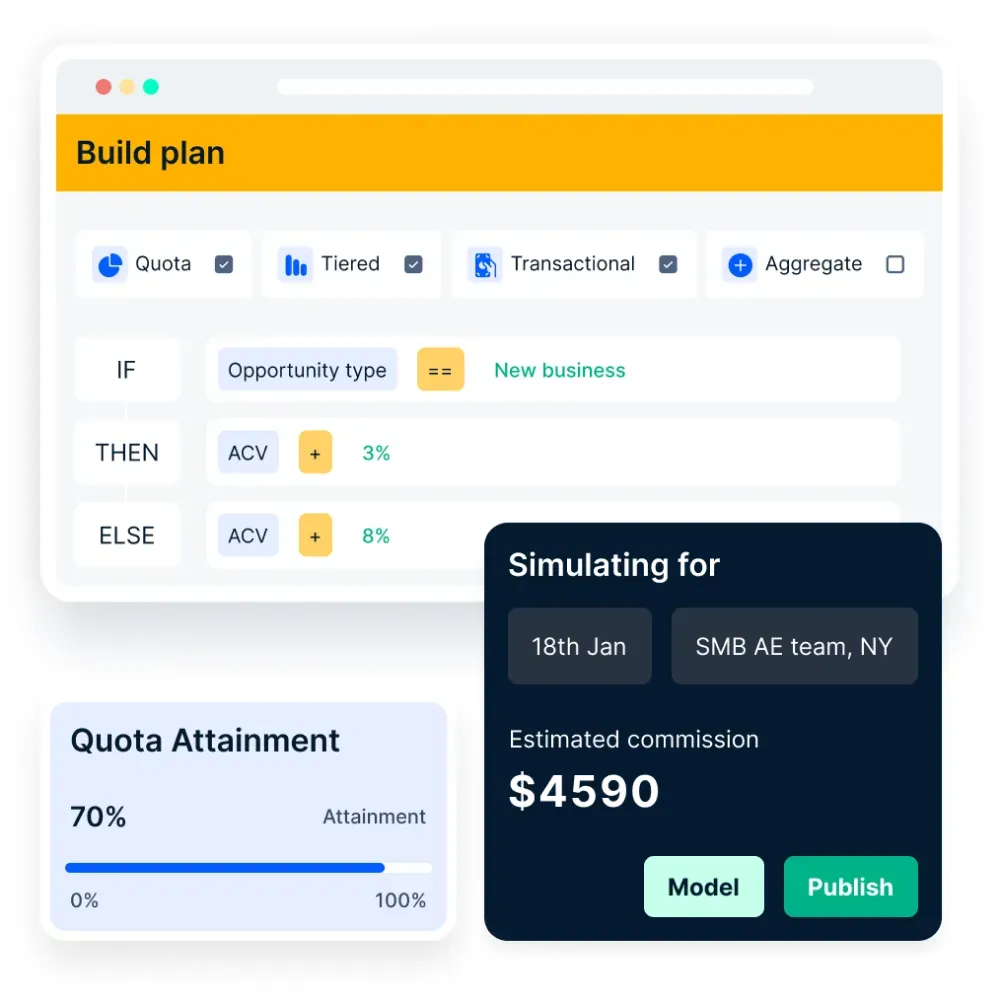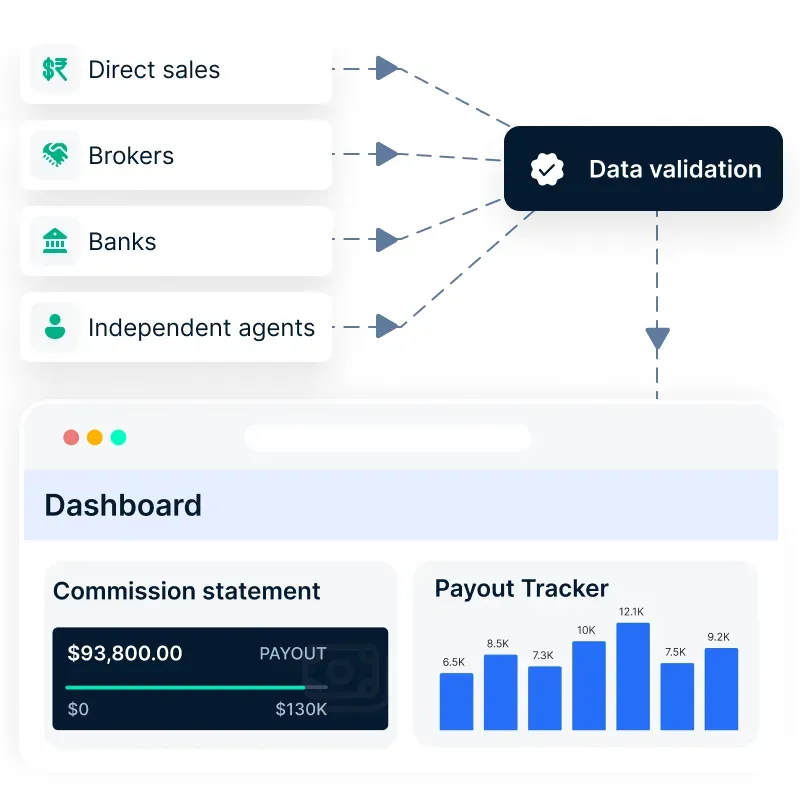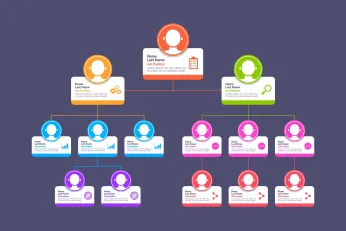Di halaman ini
A well-structured sales incentive compensation program is a powerful tool for driving revenue growth and enhancing sales team performance. When designed effectively, these programs align sales behaviors with business objectives, motivating reps to exceed targets while ensuring long-term profitability. However, simply offering incentives is not enough—following sales incentive programs best practices is crucial to maintaining engagement and productivity.
Companies that implement best practices in sales incentive plan design create transparent, data-driven compensation structures that reward high performance while promoting sustainable sales growth. Research shows that engaged and motivated sales teams contribute to higher profitability and reduced turnover, making strategic incentive planning a business necessity. This blog will share best practices in sales incentive planning and compensation.
Apa yang dimaksud dengan kompensasi insentif penjualan?
Incentive compensation is additional money sales representatives earn on top of their regular base salary and bonuses whenever they close a deal or achieve a specific business objective.
A representative might be earning a commission or a bonus, but mostly this is given out as cash and forms a part of his existing compensation plan.
On the other hand, sales incentive compensation is designed to stimulate certain behaviors in the sales teams, which undoubtedly enables higher sales and serves as a tool for motivation and recognition.
It has an intrinsic value that extends beyond monetary worth. Recipients view this compensation as celebratory, with a sense of appreciation and recognition, making them more memorable.
This incentive can take many forms and may include noncash rewards like prizes, tickets, annual family holiday packages, team holidays, etc. With a properly designed and delivered sales incentive compensation plan, salespeople maximize their rewards, and the organization maximizes revenue.
The best sales incentive plan for your organization should be simple enough for the sales reps to understand its working so that they take necessary actions to hit their goals.
How does incentive compensation management work?
Incentive compensation management automates commission and bonus calculations, providing real-time tracking for sales reps to monitor earnings and payouts. The right system simplifies plan administration, making updates and adjustments seamless.
For effective implementation, incentive programs must align with business goals and sales strategies. A well-designed plan ensures that variable compensation reflects performance, driving motivation and results. Integrating this software with a sales CRM enhances visibility, helping reps understand their earnings and performance metrics.
Managing incentive compensation manually is complex and prone to errors, leading to miscalculations, payment delays, and disengaged sales teams. Compass automates the entire incentive compensation management (ICM) process, ensuring real-time tracking, accurate payouts, and seamless plan administration.

With Compass’s no-code platform, businesses can design, publish, and manage incentive plans for any role without requiring technical expertise. Additionally, hierarchy-based approval workflows ensure that earnings approvals, escalations, and disputes are handled efficiently, eliminating miscommunication between teams.
Why is incentive compensation management important?
Effective incentive compensation management is key to driving performance and retention. It ensures fair, transparent pay structures that align team behavior with company objectives. By automating processes, businesses reduce errors and save time.
- Aligns sales efforts with company objectives.
- Boosts morale and retention with clear, fair compensation.
- Reduces errors and saves time by automating manual processes.
- Attracts top talent with structured, competitive pay plans.
- Enhances forecasting and financial planning through accurate tracking.
Without efficient compensation tracking, businesses risk errors, inefficiencies, and disengaged sales teams.
Errors and inefficiencies in incentive management can lead to financial losses, disengaged employees, and disputes. Compass eliminates manual miscalculations and ensures error-free payouts by automating commission tracking.
Its flexible data management seamlessly integrates with leading CRMs, ERPs, HRMs, and Payroll systems like HubSpot, SAP S/4HANA, Workday, Zuora, QuickBooks, Salesforce, Zoho CRM, Sage, and Google Sheets, providing a fully connected and automated workflow.

By leveraging real-time tracking and automated calculations, Compass helps businesses improve accuracy, enhance transparency, and reduce administrative overhead.
Specific types of incentive compensation
Organizations use various types of incentive compensation to drive performance and engagement. Here are some common examples:
- Performance-based bonuses reward employees for achieving specific goals. For example, a marketing manager may receive a bonus for increasing website traffic by 20% in a quarter.
- Restricted stock units (RSUs) grant company stock that vests over time. A tech company might offer RSUs to software engineers as part of their compensation package to encourage long-term commitment.
- Profit-sharing bonuses distribute a portion of company profits to employees. A manufacturing firm, for instance, might give annual bonuses based on company earnings to all employees.
- Commission-based pay provides a percentage of sales revenue. A car salesperson earning 5% commission on every vehicle sold is a common example of sales incentive compensation.
Some organizations use a single incentive type, while others combine multiple forms. Finding the right mix ensures employees stay motivated and aligned with company goals.
Bagaimana rencana kompensasi insentif penjualan dirancang?
Typically, in most organizations, sales leadership and sales operations teams create and manage the sales incentive compensation plan. They take valuable inputs from functions like finance, marketing, IT, and HR on other important parameters aligned with organizational goals and sales metrics. During the designing and adoption process, the plan may be revised multiple times and re-assessed basis disputes on buy-in from the wider sales team, business environment, and overall effectiveness.
Dengan begitu banyak metrik yang harus dilacak, penghitungan yang rumit, penyertaan berbagai penyesuaian, merancang kompensasi insentif tidak diragukan lagi merupakan tugas yang berat. Ditambah lagi dengan kebutuhan akan visibilitas waktu nyata, dasbor yang mudah dipahami, dan wawasan, tim perancang insentif akan mengalami kesulitan. Ada baiknya untuk memperhatikan tiga prinsip dasar yang disebutkan di bawah ini saat merancang rencana kompensasi insentif:
Prinsip-prinsip organisasi
Prinsip-prinsip ini adalah tentang menghubungkan rencana insentif dengan tujuan perusahaan yang lebih besar. Hal ini melibatkan
- Memberikan bobot yang memadai untuk setiap tujuan dan mengukurnya secara akurat
- Termasuk fleksibilitas untuk menyesuaikan rencana insentif dengan perubahan apa pun di pasar, atau perubahan tujuan bisnis
Prinsip-prinsip motivasi
Prinsip-prinsip ini menghubungkan rencana insentif dengan personalisasi nilai dan peran dalam organisasi. Hal ini dapat mencakup
- Memberikan insentif yang lebih bersifat emosional (rasa pencapaian, status sosial) daripada sekadar utilitarian
- Menggunakan algoritme prediktif untuk memperkirakan target penjualan individu daripada hanya persentase kenaikan yang sama untuk semua orang
Prinsip-prinsip perilaku
Prinsip-prinsip ini menghubungkan rencana insentif untuk mendorong perilaku yang diinginkan pada individu dan tim. Hal ini mengarah pada
- Memberikan insentif untuk peningkatan kualitas prospek daripada hanya mengejar jumlah target
- Metrik seperti penurunan keluhan pelanggan dibandingkan dengan kuartal terakhir
Setelah selesai, rencana kompensasi insentif penjualan harus dikomunikasikan dengan baik di dalam organisasi. Komunikasi yang buruk dari rencana yang bagus lebih buruk daripada komunikasi yang baik dari rencana yang biasa-biasa saja. Ada kebutuhan untuk pelatihan online, dokumen FAQ, dan saluran terbuka untuk menjawab keraguan tim penjualan setelah peluncuran rencana insentif penjualan dilakukan.
Karena biaya yang tinggi terlibat dalam setiap kompensasi insentif dan potensinya yang besar untuk mendorong perilaku penjualan, memaksimalkan Pengembalian Investasi atas kompensasi Insentif sangat penting bagi bisnis. Tetapi ROI pada rencana insentif adalah pengembalian finansial yang lebih tinggi atas belanja modal tetapi berdampak secara keseluruhan pada organisasi, mulai dari tim penjualan yang termotivasi secara strategis hingga gesekan yang lebih rendah hingga pembayaran yang tepat waktu dan prediksi bisnis yang lebih baik.
Menghitung ROI yang dihasilkan oleh rencana insentif bukanlah tugas yang mudah. Untuk menghitung dalam bentuk uang, Anda dapat melihat peningkatan pendapatan (dan/atau pangsa pasar yang diperoleh, jumlah pelanggan yang diakuisisi, tingkat perputaran inventaris, dan lain-lain) dan mengurangi biaya keseluruhan untuk mengimplementasikan dan mengelola program. Namun untuk dampak non-moneter, Anda perlu menetapkan metrik pengukuran keberhasilan di awal saat membuat rencana insentif. Sebagai contoh, beberapa faktor tidak berwujud seperti adopsi pelatihan, ketidakhadiran, skor kepuasan karyawan dalam survei, biaya kehilangan atau mendapatkan pelanggan baru dapat memberikan nilai yang dirasakan dari program insentif dan berdampak pada motivasi tenaga penjualan.
Banyak penelitian yang dilakukan oleh Incentive Research Foundation menunjukkan bahwa sama sekali tidak ada keraguan bahwa insentif perlu dirancang berdasarkan aset terbaik Anda - karyawan. Ketika karyawan mengidentifikasi diri mereka dengan organisasi dan merasakan rasa memiliki serta didengar, mereka secara intrinsik termotivasi untuk bekerja dengan baik dalam tugas-tugas mereka dan memberikan nilai yang lebih tinggi serta apresiasi yang lebih dalam terhadap imbalan rencana kompensasi insentif.
Praktik terbaik penjualan untuk meningkatkan ROI untuk kompensasi insentif penjualan
To increase your ROI for Sales Incentive Compensation, here are four sales best practices to follow. Let’s explore each of these sales best practices in detail.
1. Mengotomatiskan untuk menghilangkan kesalahan
Merancang rencana kompensasi insentif bukanlah tugas yang mudah. Dengan banyaknya peran yang harus dinilai, perhitungan yang besar, waktu yang dihabiskan untuk mengumpulkan informasi di seluruh tim, mengelola jejak digital dari perubahan dan peristiwa, dll., proses manual pasti akan salah.
Ketidakakuratan dalam perhitungan adalah pedang bermata dua - baik dalam kasus kelebihan pembayaran maupun kekurangan pembayaran kompensasi, bisnis harus membayar harga yang mahal. Kelebihan pembayaran menyebabkan kerugian finansial langsung bagi organisasi dan penurunan ROI. Sebaliknya, kekurangan pembayaran menyebabkan berkurangnya kepercayaan karyawan, menurunnya kinerja penjualan, dan bahkan biaya pertarungan hukum jika karyawan mengajukan gugatan atas pembayaran yang tidak akurat!
When sales representatives doubt the payments being made to them, their time, which ideally should be spent selling and bringing more business, is wasted on shadow accounting. Many organizations provide automation of sales incentive plans and can help make the process efficient. Consider investing in an automated incentive compensation management solution if you plan to keep your sales teams motivated and achieve accuracy in payments.
Compass eliminates these errors with automated commission calculations, ensuring fair compensation and eliminating disputes. Sales teams can focus on selling rather than shadow accounting, increasing overall productivity.
2. Menghadirkan efisiensi operasional untuk mengurangi biaya
Ketika sistem kompensasi insentif penjualan diotomatisasi, jumlah sumber daya yang dibutuhkan untuk melakukan perhitungan manual akan berkurang dan mengurangi waktu perhitungan, yang jika tidak, bisa mencapai berhari-hari setiap bulannya.
Sekarang, dengan mengotomatiskan alur kerja, terdapat peningkatan efisiensi sistem dengan berkurangnya waktu yang dihabiskan untuk entri data, risiko yang lebih rendah dari potensi perselisihan di lini produksi, dan penghematan biaya dalam hal kebutuhan sumber daya yang lebih rendah.
Compass streamlines the sales compensation process, reducing manual workload, decreasing calculation time, and eliminating administrative inefficiencies. By automating data entry and workflows, organizations lower resource costs while improving accuracy and speed.
3. Gunakan wawasan digital untuk meningkatkan kinerja
Manual incentive calculations cannot provide advanced digital insights both to sales leaders as well as sales reps. With a digital representation of his personalized performance data and variable compensation on an automated sales incentive compensation model, a sales representative can easily understand the results, so he invests time improving his metrics and is more satisfied and less likely to leave the organization. Sales leaders have better insights in struggling areas for their sales reps and can coach their marginal performers better and personalize their coaching, leading to improved performance.
Dalam dunia yang kompetitif, perusahaan tidak boleh mengabaikan alat bantu digital yang dimanfaatkan oleh kompetitor mereka. Alat perencanaan dan wawasan insentif penjualan otomatis adalah salah satu alat tersebut. Alat ini memberikan wawasan data yang berharga tentang bisnis secara keseluruhan, yang membantu dalam perencanaan masa depan yang lebih baik dan mengarah pada peningkatan jumlah penjualan.
Ketika sejumlah besar uang telah dihabiskan untuk kompensasi tenaga penjualan, sangat penting untuk membandingkan rencana insentif dan kompensasi penjualan Anda dengan kompetitor untuk memahami apakah Anda mendapatkan pengembalian investasi yang memadai dan mempelajari praktik-praktik terbaik. Wawasan digital memungkinkan analisis komparatif yang cepat dan mudah untuk menerapkan pembelajaran pada bisnis dalam waktu singkat.
Compass provides real-time digital insights into sales performance, quota attainment, and commission effectiveness.
Predictive analytics helps leaders set realistic and personalized sales targets.
Benchmarking tools compare incentive structures with industry standards, allowing for optimization.
Personalized dashboards give sales reps a clear view of their earnings, goals, and commission trends.
By adopting Compass’s data analytics, organizations gain better visibility into performance trends and ensure their incentive plans drive real revenue growth.
4. Meningkatkan ketepatan waktu
Program kompensasi insentif penjualan Anda berfungsi sebagai satu versi kebenaran untuk informasi penjualan pada perhitungan yang tersebar di seluruh organisasi. Program ini membantu memberikan gambaran keuangan yang akurat untuk membuat keputusan yang lebih baik bagi bisnis.
Program kompensasi insentif yang terdigitalisasi mengotomatiskan penghitungan yang rumit, membuat akses ke informasi menjadi lebih cepat, berbagi informasi secara lintas fungsi menjadi lebih mudah, dan memungkinkan kelincahan dalam pengambilan keputusan. Tim keuangan tidak perlu menunggu hingga akhir bulan untuk mendapatkan data biaya kompensasi, namun kini tersedia sesuai permintaan. Hal ini meningkatkan kecepatan dan akurasi prakiraan bagi organisasi.
Tidak ada yang mau menginvestasikan biaya untuk kompensasi insentif dan tetap saja dirugikan. Teknologi kompensasi insentif yang canggih memungkinkan organisasi untuk mendapatkan ROI yang lebih baik dari biaya yang besar ini, menjaga tenaga penjualan mereka tetap terlibat dan termotivasi dengan insentif yang memadai, dan menyelaraskan strategi penjualan untuk pertumbuhan bisnis. Teknologi ini memungkinkan kejelasan berbasis fakta dan menggunakan algoritme yang belajar seiring dengan semakin banyaknya data yang dimasukkan, sehingga memungkinkan prediksi yang lebih baik di masa depan.
Pertimbangkan untuk menggunakan program kompensasi insentif penjualan otomatis untuk organisasi Anda jika Anda belum melakukannya. Anda akan merasakan sendiri manfaatnya.
Compass automates complex compensation calculations and provides instant access to commission data, ensuring timely and accurate payments.
Finance teams can access on-demand compensation reports instead of waiting until the end of the month, improving forecasting accuracy and business decision-making speed.
5. Automate to Eliminate Errors
Designing an incentive compensation plan is a complex task. With multiple roles to assess, large calculations, data gathering across teams, and managing a digital trail of changes, a manual process is prone to errors.
Inaccurate calculations lead to overpayment or underpayment, both of which harm the business. Overpayment results in financial losses and reduced ROI, while underpayment diminishes employee trust, decreases performance, and could even lead to legal disputes.
Sales representatives who question their payments waste valuable selling time on shadow accounting. Investing in an automated incentive compensation management solution ensures accuracy, reduces disputes, and keeps sales teams motivated.
Compass eliminates errors through automated commission calculations, ensuring fair compensation and reducing disputes. This allows sales teams to focus on selling rather than verifying payments, ultimately improving productivity.
6. Bring Operational Efficiency to Reduce Costs
Automating the sales incentive compensation system reduces resource allocation for manual calculations and significantly cuts down processing time. By automating workflows, organizations improve efficiency, lower the risk of disputes, and reduce costs associated with administrative work.
Compass streamlines the sales compensation process by reducing manual workload, decreasing calculation time, and eliminating inefficiencies. Automation lowers resource costs while improving accuracy and speed.
7. Improve Timeliness
An automated incentive compensation program provides real-time insights into financial data, facilitating better business decision-making. By eliminating delays in accessing compensation cost data, organizations can improve forecasting speed and accuracy.
Compass automates complex compensation calculations and provides instant access to commission data, ensuring timely and accurate payments. Finance teams can access compensation reports on demand, improving forecasting accuracy and decision-making speed.
Case Study: Automating Sales Commission for Asia’s Largest CNC Machine Manufacturer
The application of this best practice can be evident in the case study below.
Tantangan
A leading CNC machine manufacturer with 32+ global sales locations faced challenges in managing its sales commission process. The company needed a solution to:
- Provide real-time visibility into incentive calculations for sales reps.
- Reduce manual effort in commission processing.
- Eliminate reliance on sales leaders for handling commissions manually.
Solution: Compass Sales Commission Management
To address these challenges, the company implemented Compass, which:
- Automated commission calculations with real-time tracking.
- Provided gamification features (leaderboards, scorecards, quizzes) to increase engagement.
- Enabled workflow automation with approval mechanisms to reduce errors and delays.
Impact & Results
By leveraging Compass’s automation and engagement tools, the company achieved:
- 20% increase in quota attainment within 90 days.
- 22% increase in incentive program qualifiers.
- 73% higher platform adoption among sales teams.
- Improved payout accuracy and reduced dependency on sales leaders for manual commission handling.
This case study highlights how Compass transformed incentive compensation management, ensuring accuracy, efficiency, and higher sales engagement, in short by implementing sales incentive compensation best practices.
Kesimpulan
Implementing sales incentive compensation best practices ensures a motivated sales force, higher revenue, and long-term business growth. By leveraging automation, digital insights, and strategic planning, companies can create transparent, results-driven compensation structures.
A well-structured incentive plan not only improves sales performance but also enhances employee engagement and retention. To stay competitive, businesses must continuously optimize their incentive programs, align them with evolving goals, and leverage technology for seamless execution. To stay ahead of the competition, schedule a call now with Compass!
Pertanyaan Umum
What are the three sales compensation methods?
The three main sales compensation methods are:
- Salary-only: Fixed pay without performance-based incentives.
- Commission-only: Pay is entirely based on sales performance.
Base salary + commission: A combination of fixed salary and variable commissions based on sales results, offering stability and motivation.
What is a good sales incentive plan?
A good sales incentive plan is clear, motivating, and aligned with company objectives. It should reward key sales behaviors, offer competitive compensation, and include achievable yet challenging targets to drive performance and revenue growth.
What is a 70/30 compensation plan?
A 70/30 compensation plan means that 70% of a salesperson’s earnings come from a fixed base salary, while 30% is variable pay based on performance (commissions, bonuses, or incentives). This structure provides financial stability while still incentivizing high performance.
What is the best sales compensation plan?
The best sales compensation plan aligns with business goals, motivates sales reps, and balances fixed and variable pay. It should be performance-driven, data-backed, and structured to reward both individual and team achievements while ensuring long-term profitability.













